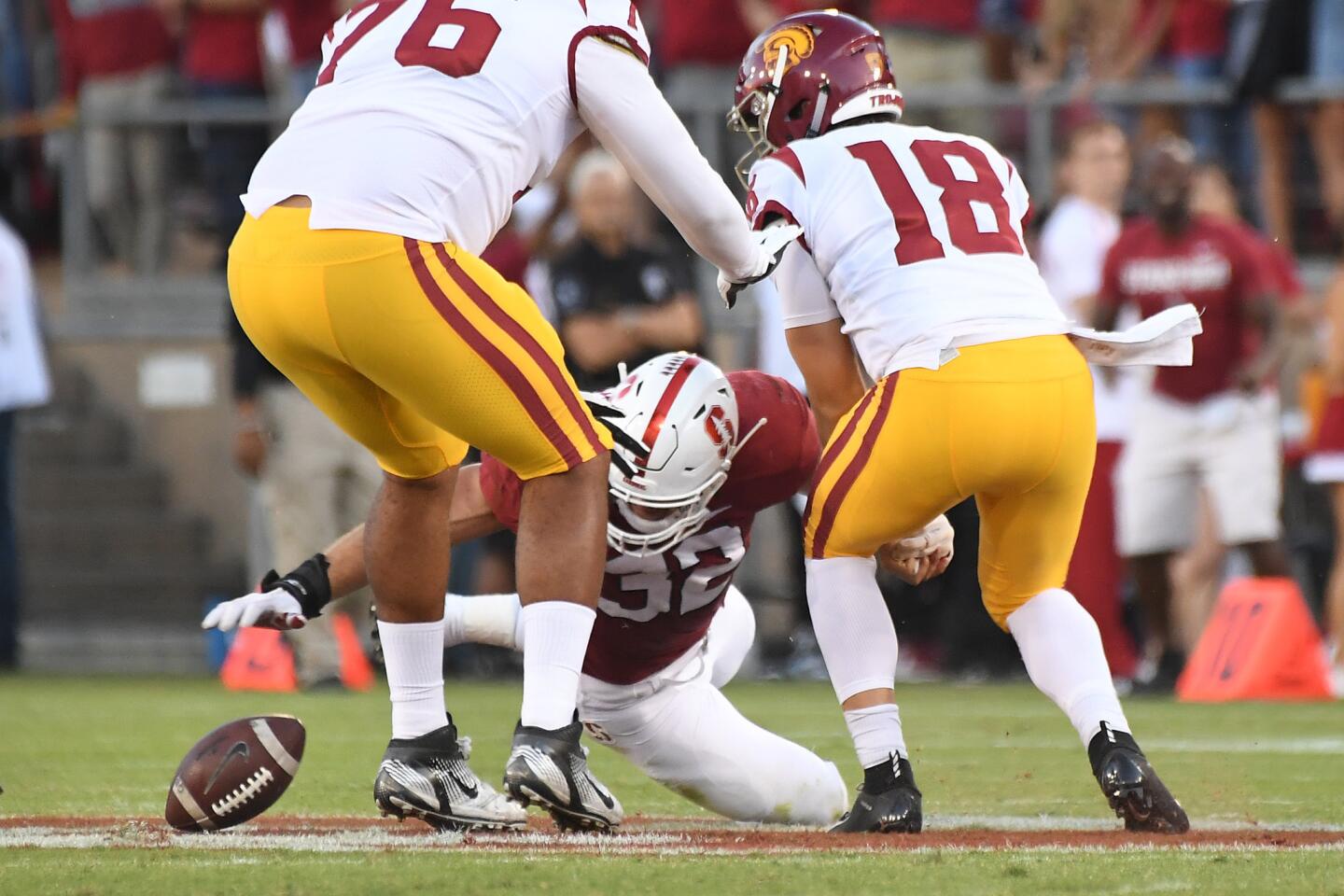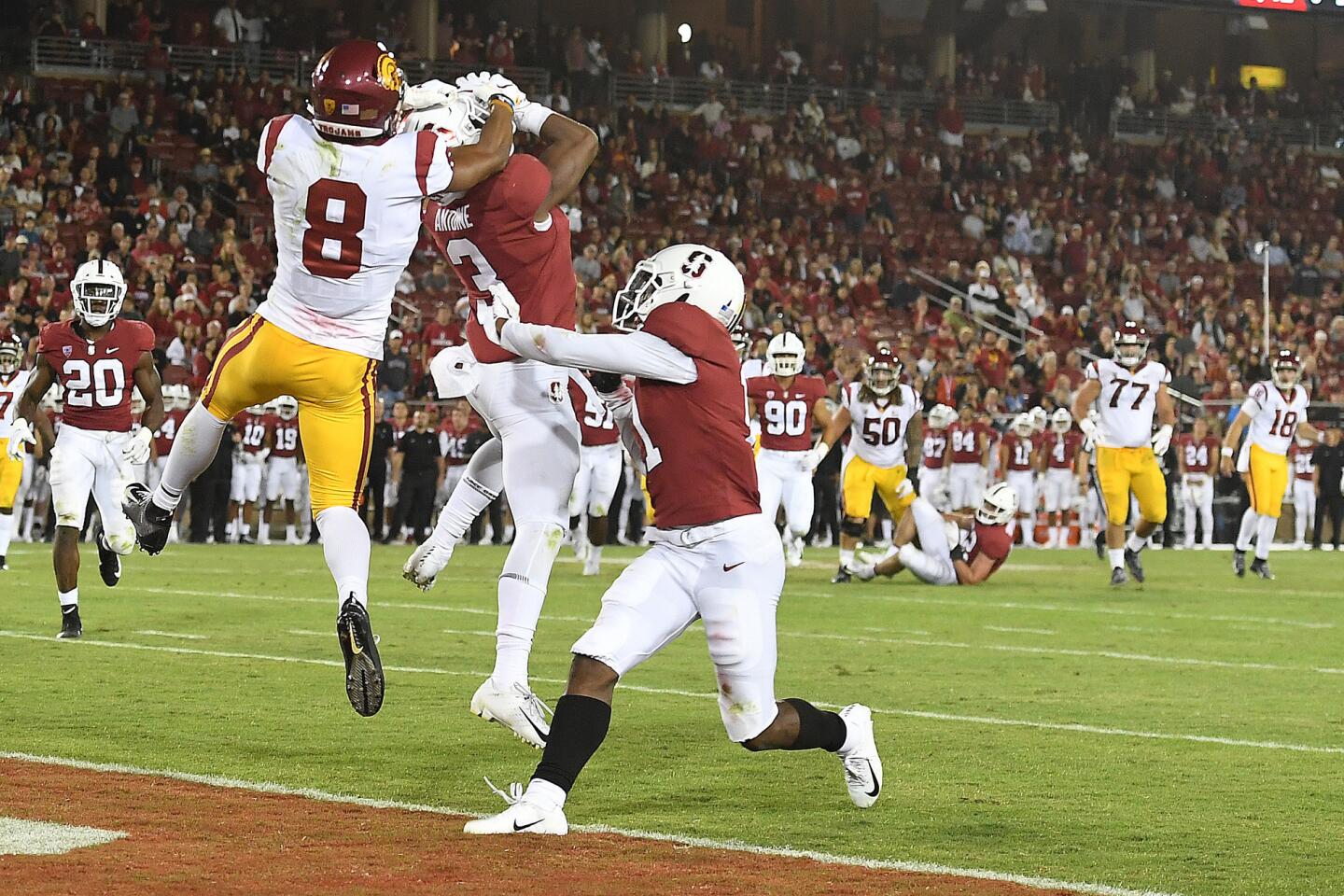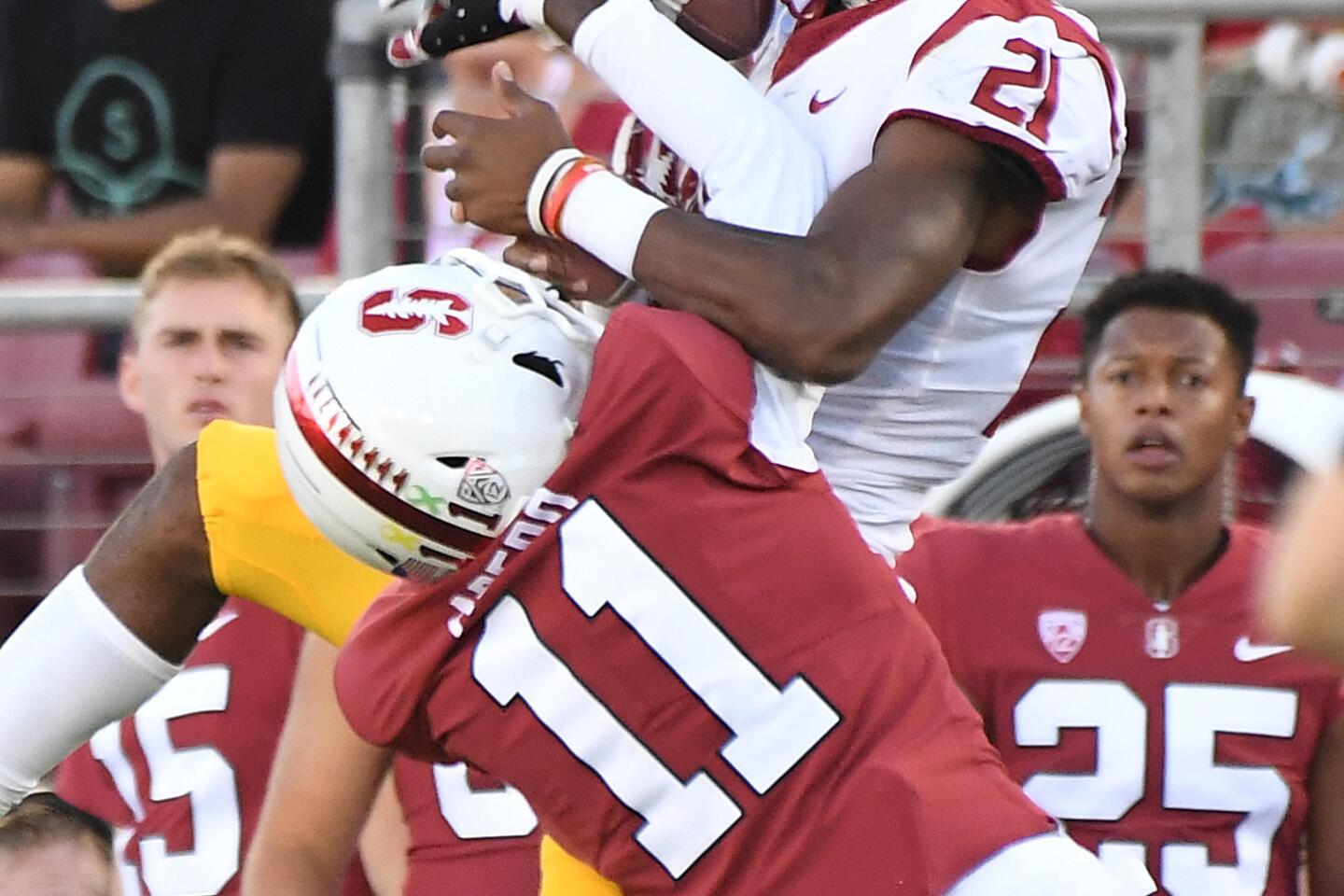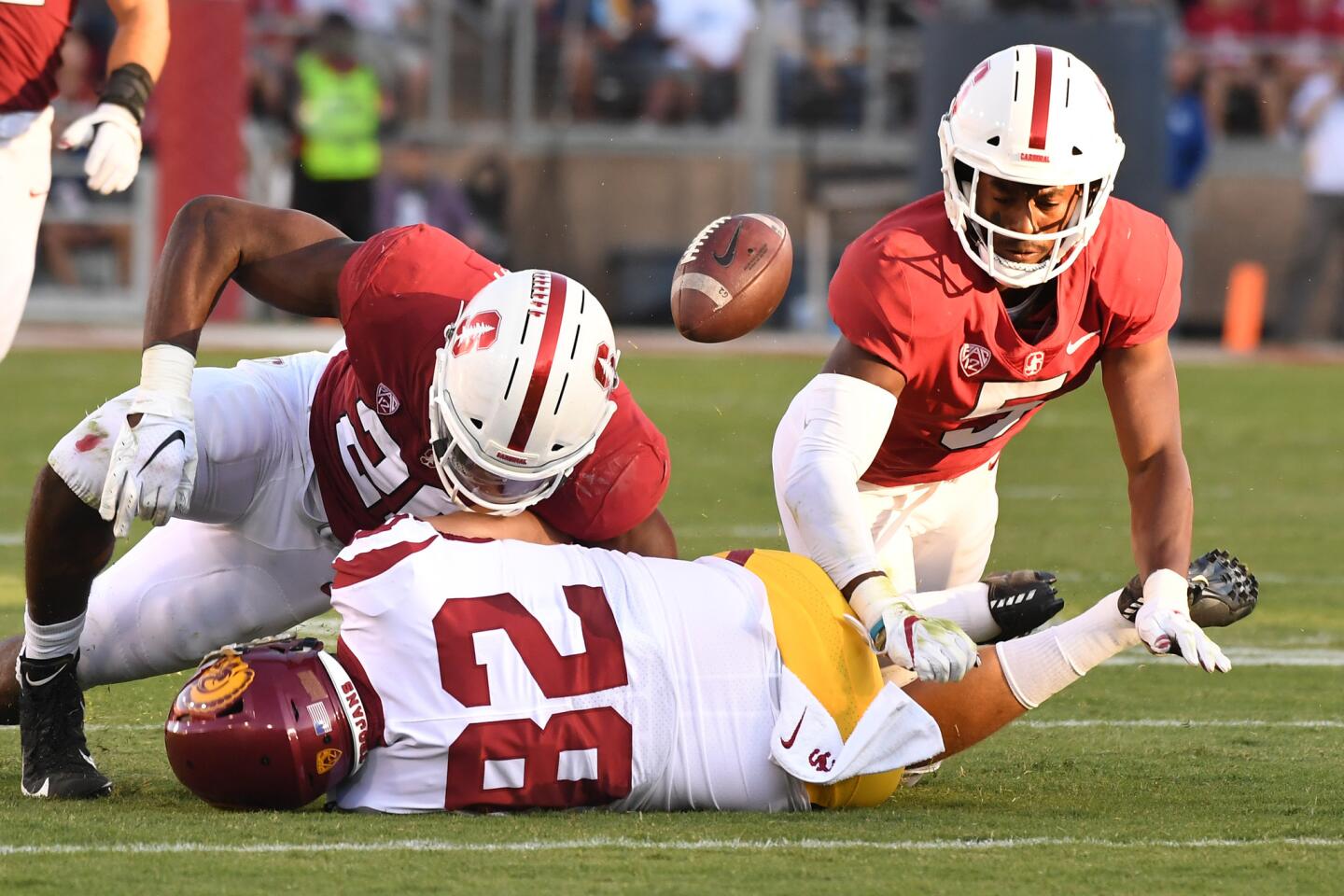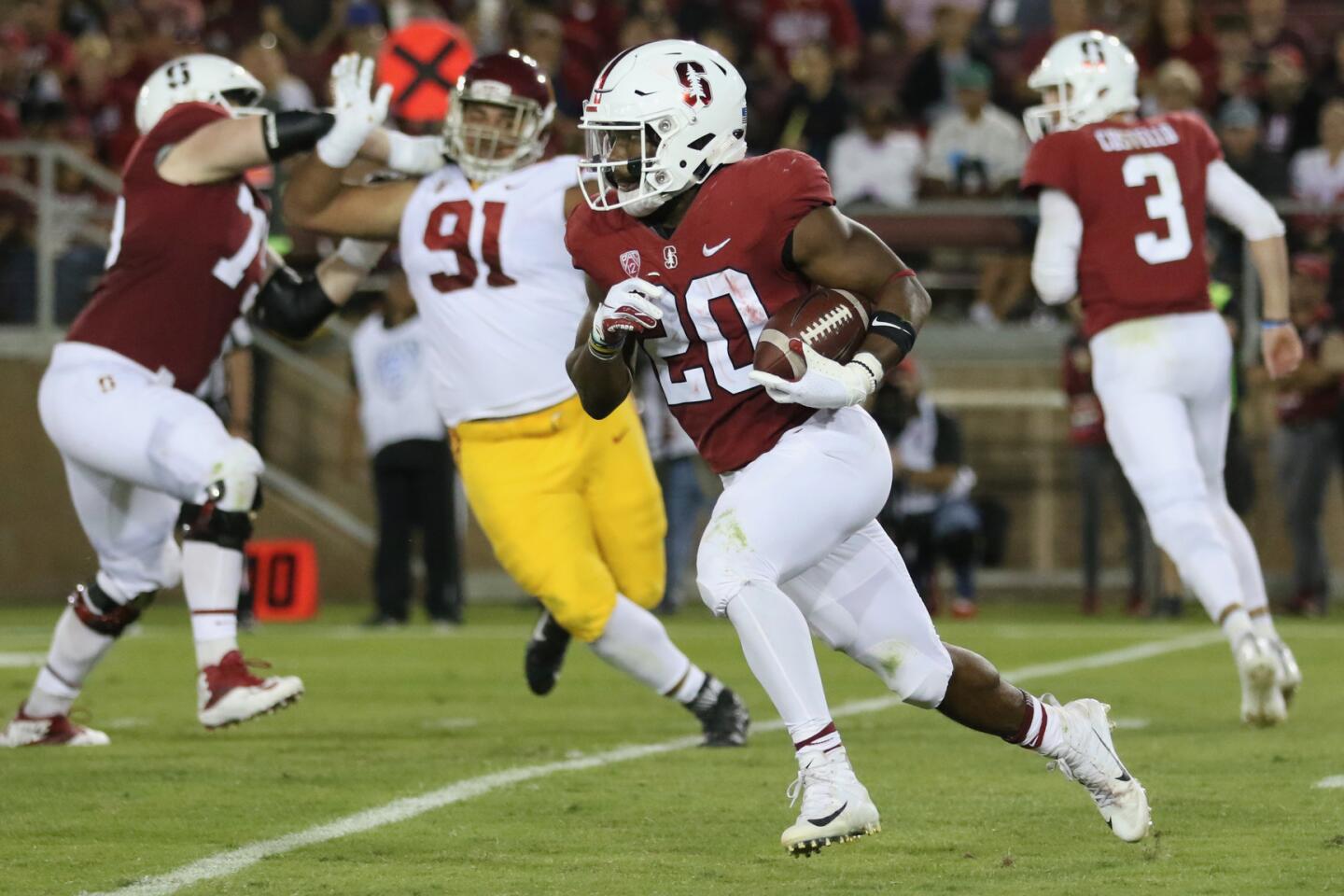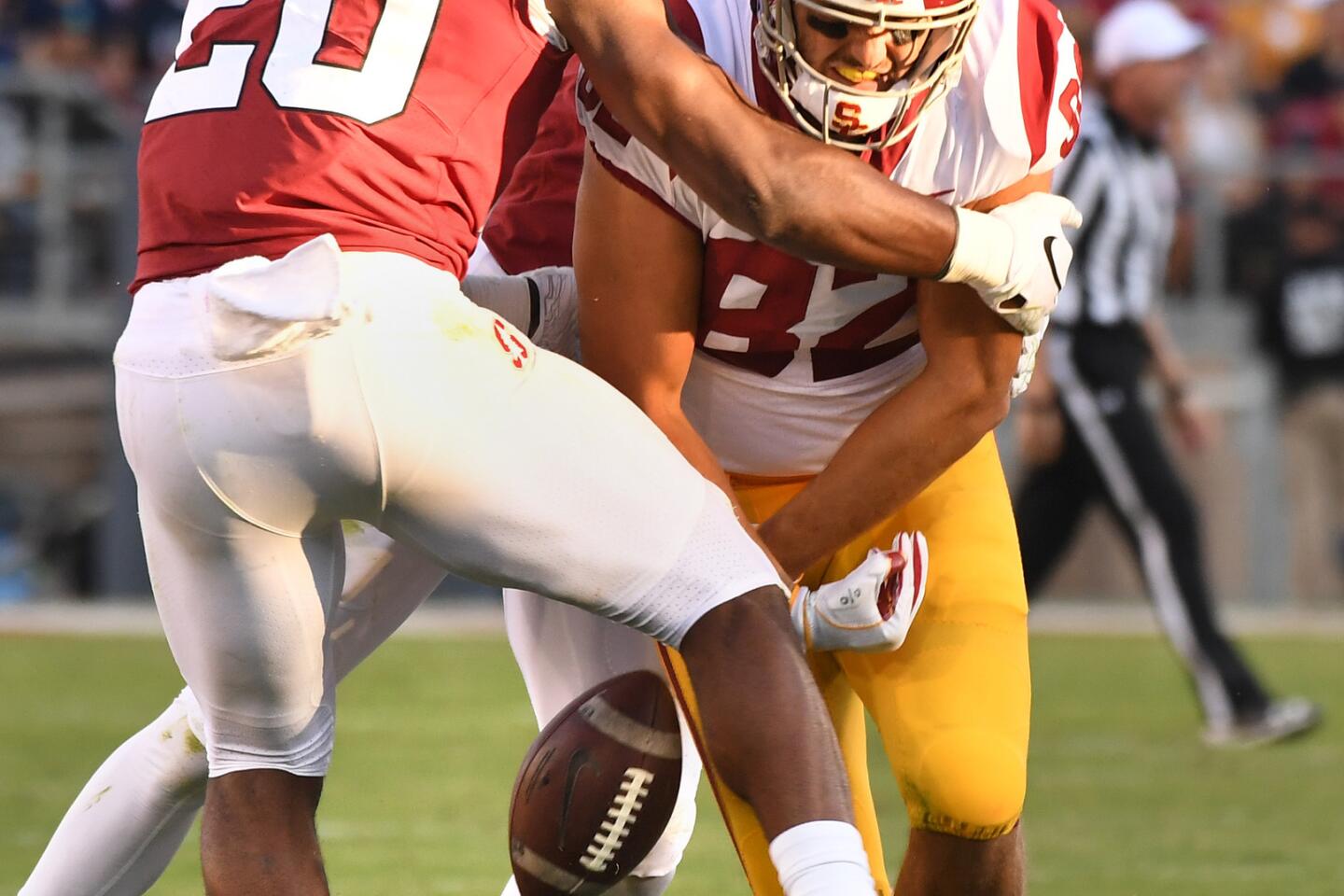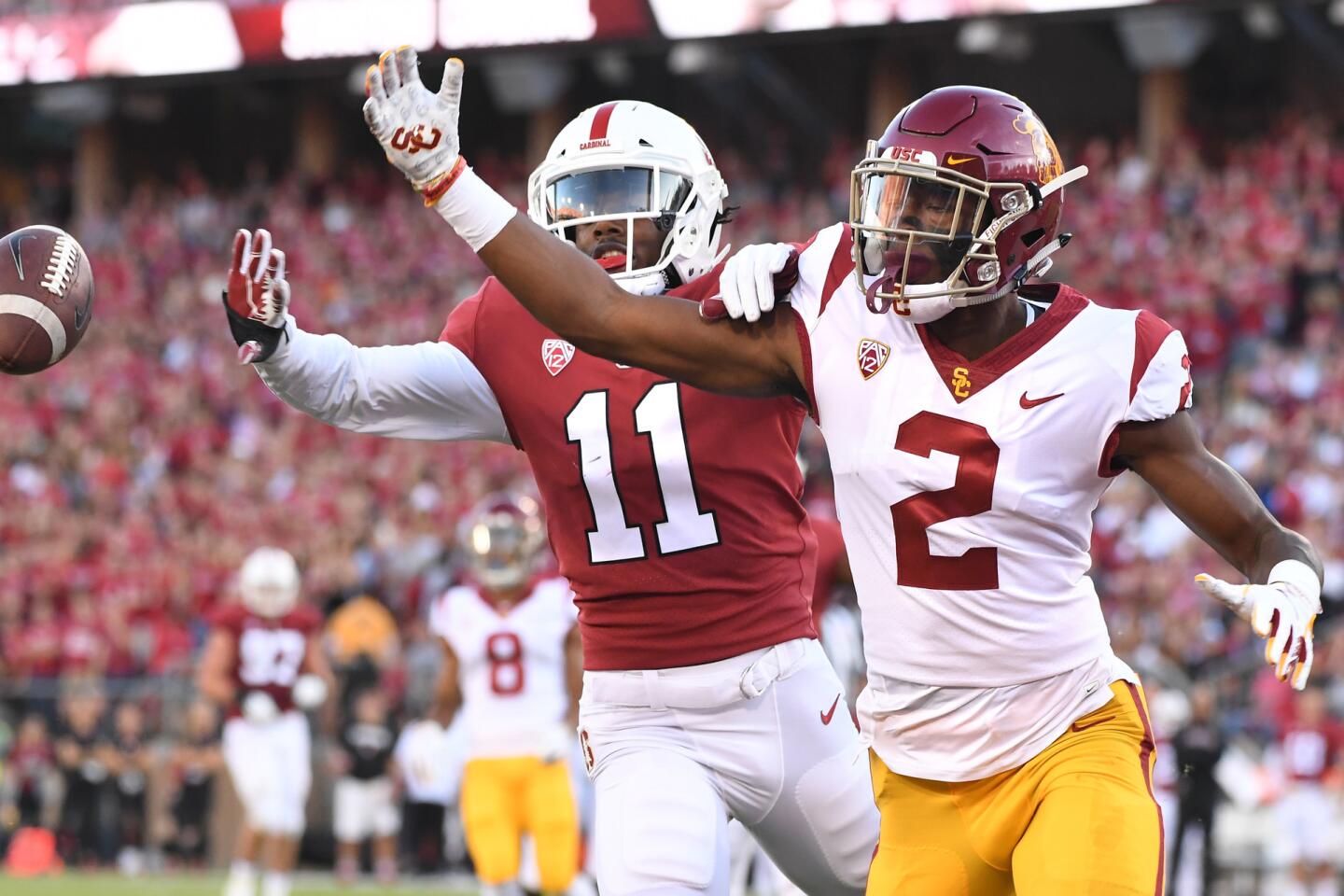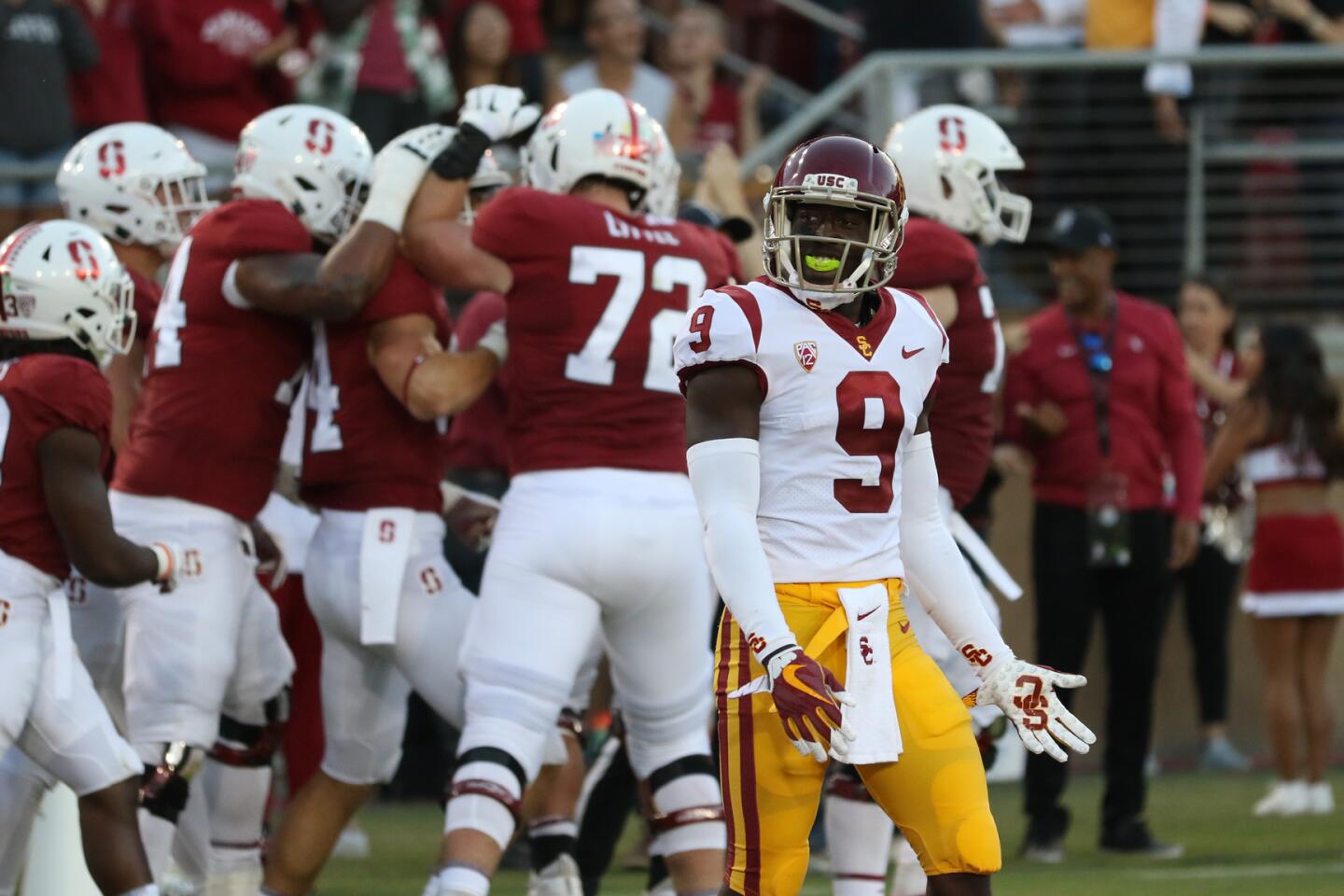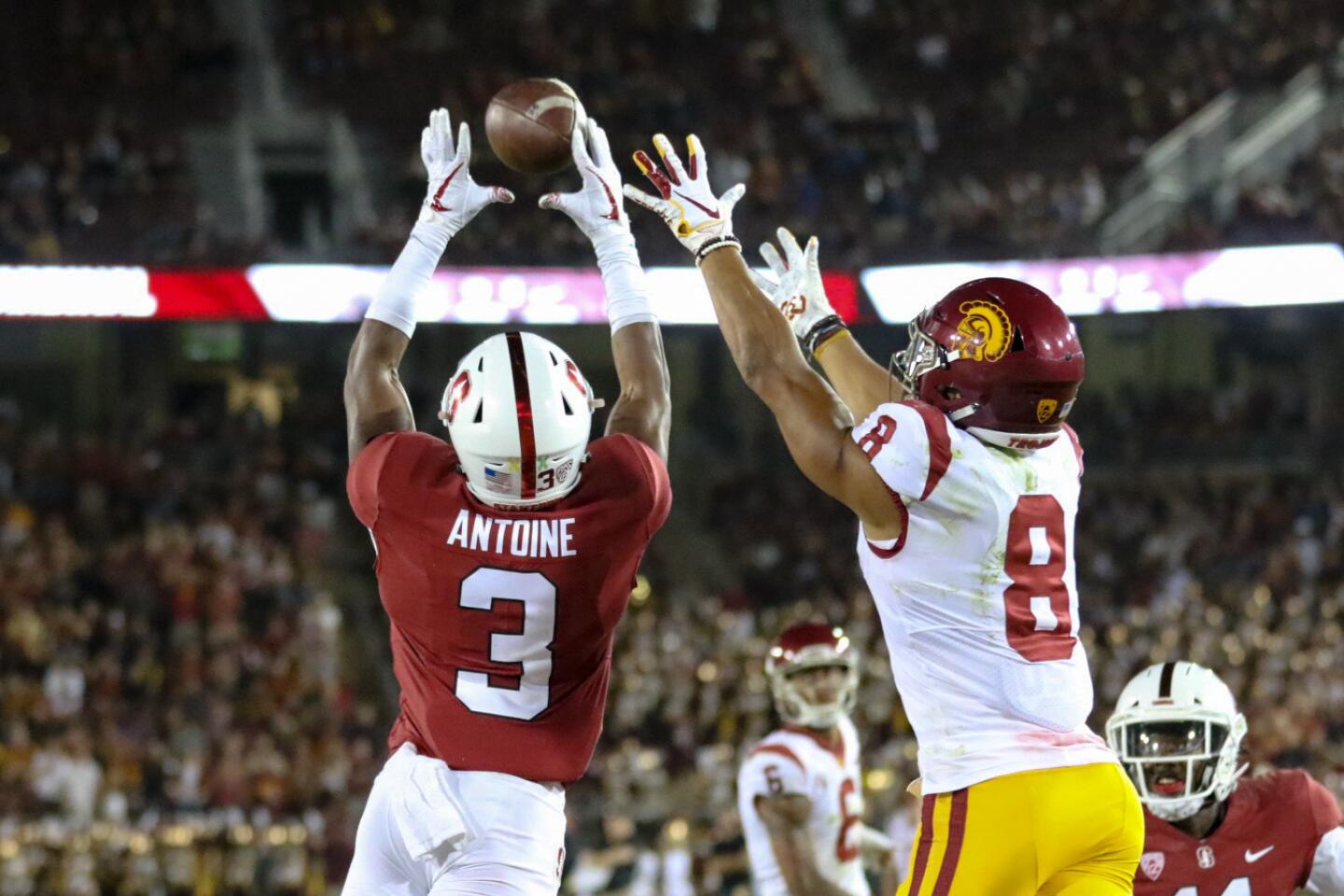Column: USC’s JT Daniels needs help from his backfield
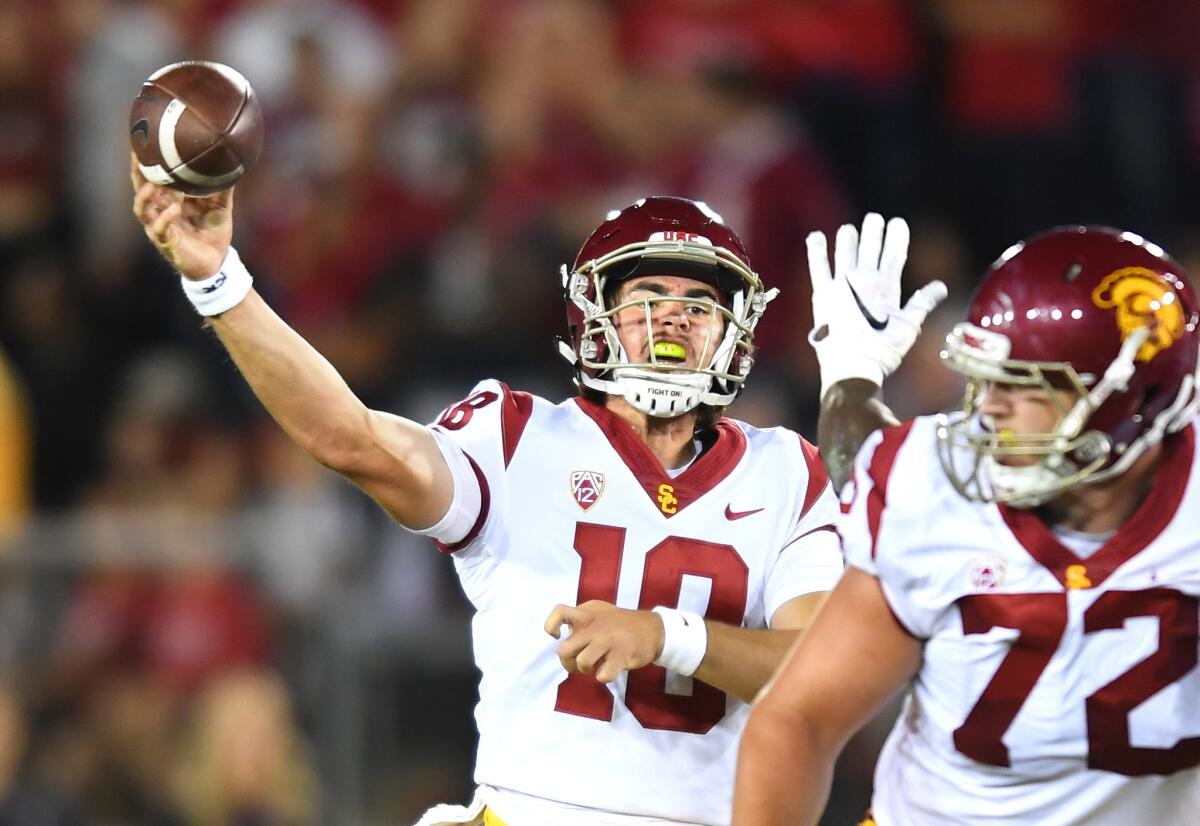
- Share via
Reporting from Palo Alto — The kid quarterback was getting hammered. His streaking receivers were being smothered.
Amid another bone-crushing Saturday evening at Stanford Stadium, between a variety of punches that dropped its finesse players to their knees, USC was hit hardest by the simplest of questions.
Why wouldn’t the Trojans run the dang football?
When will vibrant young USC realize the way to prosper in the early stages of the JT Daniels era is to act like old-school USC?
They have the backs. They have the need. They have the culture. They have the tradition. But during a frustrating battle against the seemingly beatable Cardinal, they didn’t have the dedication to the ground game, and thus were chewed up in a historically notable 17-3 defeat.
Just wondering, but if they aren’t going to attempt to pound the ball against one of college football’s most ball-pounding teams, then who? And if they aren’t going to do it in the first games of a young quarterback who needs more protection and less pressure, then when?
Before the game, USC linebacker Porter Gustin told reporters, “We will be able to find out the identity of this team.”
While watching running backs Aca’Cedric Ware, Vavae Malepeai and Stephen Carr churn up the Stanford defense in the first half, that identity seemed clear.
To everyone, it seemed, but the Trojans.
“It will be something that will open our eyes,” said Gustin.
You want an eye opener? This was the fewest points USC scored against Stanford in 77 years.
After splitting its first two games, USC looks like a team that needs to punch instead of finesse, slug instead of soar. This one conference loss is not a season killer, it doesn’t eliminate them from the Pac-12 championship race, there’s a long autumn still ahead, but it will be a bitter one if they can’t change their approach.
“All our hopes and aspirations and dreams are still out there, and our team understands that,” said coach Clay Helton afterward. “They are ready to move forward and continue to work and get better.”
They have to move forward on the ground. This became obvious Saturday when their defense stifled Stanford for most of the night, but the effort was wasted because too much burden was placed on the USC quarterback.
Yes, Daniels is going to be a great one. But he’s 18 and, as Saturday showed, he needs help. His second college game was filled with pains, growing and otherwise.
He was constantly chased and harassed while his receivers were always dancing through traffic. He completed less than half of his passes — 16 of 34 for 215 yards — while throwing two interceptions.
Meanwhile, the three running backs were used inconsistently even though each of them reeled off runs with double-digit yardage and they combined for 129 yards, almost matching the 136 yards of Stanford’s Bryce Love, specifically Carr, who carried the ball only 10 times, even though he averaged 5.2 yards per carry.
But it turns out they made an even bigger impact when they were not used. They led USC downfield twice on a couple of punishing drives in the second quarter, but at the end of those drives, they disappeared.
USC stalled on the Stanford 35-yard line with a hurried incompletion by backup Matt Fink, followed by a missed 53-yard field goal attempt by Chase McGrath. On USC’s ensuing drive, they churned out 44 more yards and had a first down on the Stanford 37. But Daniels overthrew a well-defended Devon Williams, Ware was stuffed, then Daniels tossed the ball away on a poorly constructed screen.
“We got it down there, we missed some opportunities,” acknowledged Helton, noting that they had this same problem in the opening win against UNLV. “Obviously we have to be able to push it in and get better. That’s back-to-back games.”
There was probably no greater missed opportunity than in the final minutes of the first half, when the running backs were almost completely ignored on a failed drive that may have decided the game.
With Stanford leading only 7-0 against a raucous USC defense, the Trojans had a chance to finish the half with a punch when it took over on its 35-yard line with 3:04 remaining in the second quarter.
The Trojans had been so successful running the ball earlier, surely they would continue pounding it and running clock and moving into scoring position?
Nope. They suddenly and radically changed gears, calling five straight pass plays that featured two incompletions and 25 total yards. At this point, on third-and-two, they finally ran, but Carr was stuffed. Then they ran a fourth-down pass play during which the ball was stripped from Daniels and recovered by Stanford’s Bobby Okereke around midfield.
Not only did the Trojans not move the ball, they didn’t move the clock, and Stanford quickly moved back down the field, covering 51 yards in just 44 seconds to score a second touchdown from which the Trojans never fully recovered. It came on a nine-yard touchdown from K.J. Costello to Colby Parkinson, one of their seemingly dozens of tight ends.
“We worked just like we did the first game, mixing in all three tailbacks effectively,” said Helton. “We’re trying to do everything possible to get it into our playmakers’ hands.”
Helton needs to look only at his own history to know that the Trojans can work even harder to get the ball into the running backs’ hands.
The Trojans beat Stanford twice last year in two of Helton’s signature victories. And both times they did it by running the football.
Remember that first game? They gained 307 yards rushing in a 42-24 victory. Then, remember the Pac-12 championship game? They won, 31-28, with Ronald Jones gaining 140 yards and scoring two touchdowns.
“I thought they competed like warriors,” Helton said of this latest game. “Obviously there’s some mistakes that we will clean up.”
The biggest involves the running game. They have one. They have a potentially great one. Use it.
Get more of Bill Plaschke’s work and follow him on Twitter @BillPlaschke
More to Read
Go beyond the scoreboard
Get the latest on L.A.'s teams in the daily Sports Report newsletter.
You may occasionally receive promotional content from the Los Angeles Times.


